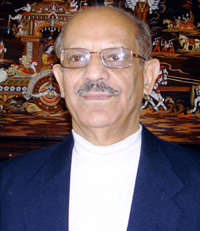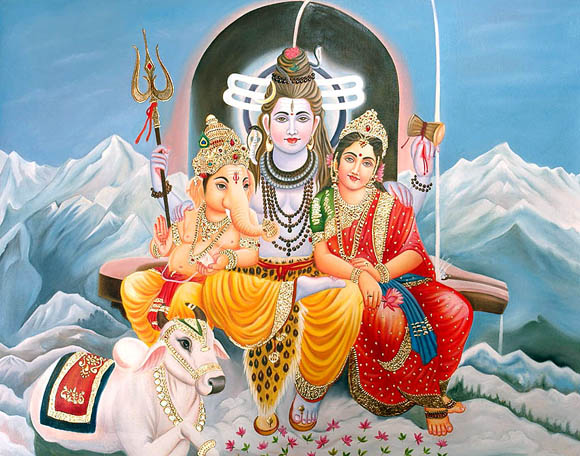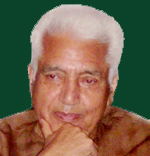Kavi Pradeep (6 February 1915 – 11 December 1998), born
Ramchandra Narayanji Dwivedi, was an Indian poet and songwriter who is best known for his patriotic song
Aye Mere Watan Ke Logo written as a tribute to the soldiers who had died defending the country during the
Sino-Indian War.
His first recognition came for his patriotic lyrics for the film
Bandhan (1940). His status as a nationalistic writer got immortalised for writing a daringly patriotic song
Door Hato Ae Duniya Walo (Move Away O Outsiders) in India's first golden jubilee hit
Kismet
(1943) because he was forced to go underground to avoid arrest
immediately after the film's release that invited the ire of British
government.
In a career span of five decades, Kavi Pradeep wrote about 1,700 songs and nationalistic poems including the lyrics for some 72 films, including hits like
Chal Chal Re Naujawan in film
Bandhan (1940) and
Aao Bachcho Tumhein Dikhayen and
De Dee Hame Azaadi Bina Khadag Bina Dhaal in film
Jagriti (1954) In 1958,
HMV, released an album of 13 songs with his lyrics. He was made the
Rashtrakavi, (Poet Laureate), and came to be known as,
Kavi Pradeep
In 1997, he was honoured by India's highest award in Cinema, the
Dada Saheb Phalke Award for Lifetime Achievement.
Kavi Pradeep was born Ramchandra Narayanji Dwivedi in 1915 into a
middle-class Audichya Brahmin family in the small central Indian town of
Badnagar near
Ujjain. Since his early student days and later while pursuing graduation from
University of Lucknow, he had a passion for writing and rendering Hindi poetry. He hypnotised the audience at
kavi sammelans (poet's gatherings) with his inimitable style. It was during this time he adopted the pen name ("nom de plume") Pradeep. After graduating from Lucknow University in 1939, he decided to join a teacher's course to become a teacher.
Pradeep was invited to a
Kavi Sammelan in
Bombay where he was offered his first film
Kangan (1939), by
Himanshu Rai of
Bombay Talkies. The film starred
Devika Rani and
Ashok Kumar.
Pradeep shifted to Bombay and wrote four songs for the film, all of
which became very popular, and sung three of the songs himself.
He next film was
Bandhan (1940) produced by
S. Mukherjee and directed by
Gyan Mukherjee. The music director was
Saraswati Devi. This time he wrote all the songs which became huge hits. The most notable is
"Chal Chal Re Naujawan", which made waves since the
Indian freedom movement was at a crucial juncture.
He worked on five more movies for Bombay Talkies which included
Punar Milan (1940),
Jhoola (1941),
Naya Sansar (1941),
Anjan (1943) and
Kismet (1943).
Kismet is known for its patriotic song
"Aaj Himalay Ki Choti Se Phir Hum Ne Lalkara Hai, Door Hato Ae Duniyawalon Hindustan Hamara Hai" (From the peak of the Himalayas we are warning other countries to stay away from India as it is our country).
Mashaal (1950) was his next film and it features the extremely popular song "Upar Gagan Vishal" sung by
Manna Dey. Kavi Pradeep was at his creative zenith when he wrote for the films
Nastik (1954) and
Jagriti (1954). He even lent his voice for the evergreen song
"Dekh Tere Sansar Ki Halat Kya Ho Gayi Bhagwaan, Kitna Badal Gaya Insaan" (Look at your world, O God. How the man has changed!) from the film
Nastik (1954). Jagriti is considered to be among his best work for one movie as it includes hit songs such as
Aao
Bachcho Tumhein Dikhayen Jhanki Hindustan Ki, Is Mitti Se Tilak Karo,
Yeh Dharti Hai Balidan Ki" (sung by himself), "Hum Laye Hain Toofan Se
Kishti Nikal Ke, Is Desh Ko Rakhna Mere Bachcho Sambhal Ke" and "De Dee
Humein Azadi Bina Khadag Bina Dhal, Sabarmati Ke Sant Tu Ne Kar Diya Kamaal".
His songs were so popular that fans would see his movies repeatedly
just to listen to his soulful songs. Kavi Pradeep always believed in
writing songs in simple words portraying a meaning fitting into the
situation. The popularity of his songs was due to his down-to-earth
lyrics and simple language that was well understood by everyone.
By the 1960s, the popularity of his songs was on the wane and film
producers who were looking for western music and fast numbers avoided
him. However he managed to prove his detractors wrong with films
Talaaq, a
Rajendra Kumar starrer and
Paigam (1959) starring
Dilip Kumar,
Raaj Kumar and
Vyjayantimala. With "Insaan Ka Insaan Se Ho Bhaichara, Yahi Paigam Hamara" being a highlight. S. Mukerji's
Sambandh (1969) starring
Pradeep Kumar
was a movie that ran on the popularity of songs such as "Chal Akela
Chal Akela, Tera Mela Peechhe Chhoota Raahi Chal Akela", "Jo Diya Tha
Tum Ne Ek Din, Mujhe Phir Wohi Pyar De Do, Ek Karz Mangta Hoon, Bachpan
Udhar De Do" were written by Kavi Pradeep. He continued to show his
brilliance in 1975, when the movie
Jai Santoshi Maa was released. For a low-budget movie, it matched the collections of another Block Buster
Sholay.
For months, theatres screening the movie, held the housefull boards
high. Ladies would perform poojas when the immortal song "Main To Aarti
Utaroon Re Santoshi Mata Ki" was played in the theatres. He also sang
one of the songs "Yahan Wahan" from the film for which he received the
award as Best Male Playback Singer from the Bengal Film Journalists'
Association in 1975.
The Patriot
Kismet
was his groundbreaking effort since it came at the time of the "Quit
India" movement. The country was in strife with all national leaders in
prison. He cleverly wrote the song "Aj Himalay Ki Choti Se Phir Hum Ne
Lalkara Hai". The song was supposed to warn the Axis powers, but the
Indian public understood the real meaning of the song. Almost synonymous
to the song (
phir means again in Hindi), the reel would be
rewound and played many times to satisfy public demand. Theatres around
the country were resounded with "once more" calls once the song ended.
The reel had to be rewound and the song was screened again and again.
Kismet
made box office history for its time by running for 3½ years in one
theatre. Though the song managed to pass through heavy censorship of the
time,
[8]
the British soon realised the true meaning of his songs and issued a
warrant for his arrest. This forced Kavi Pradeep to go underground to
avoid arrest.
He continued his patriotic zeal with renewed vigour after independence in movies such as
Jagriti with a song considered to be his tribute to
Mahatma Gandhi,
"De Dee Humein Azadi Bina Khadag Bina Dhal." His songs for children are
still played throughout the country on 14th Nov., Children's Day, "Hum
laye hain toofan se kishti nikal ke" and "Insaaf ki dagar pe."
During 1962 (Indo-China) war days, he heard about
Param Vir Major Shaitan Singh Bhati. He was so touched by his sacrifice and bravery that he penned down the lines "
Aye Mere Watan Ke Logo". This song was originally supposed to be sung by
Asha Bhosle, due to a misunderstanding between composer
C. Ramchandra and
Lata Mangeshkar.
Kavi Pradeep though, was adamant about having Lata Mangeshkar sing the
song, as he felt that hers was the only voice that could do justice to
the number. C. Ramchandra was unsure whether Mangeshkar would agree to
sing, so Kavi Pradeep began the task of convincing her to hear the song.
On hearing the song she was moved so much that she instantly agreed to
sing the song on condition that Kavi Pradeep be present at the
rehearsals.
Aye Mere Watan Ke Logo
(O people of my country) went on to become one of the greatest
patriotic songs of the country. It was while Lata Mangeshkar was
rendering the song that the Prime Minister of India,
Jawaharlal Nehru,
was moved to tears. For writing the song Kavi Pradeep was conferred the
honour of "Rashtriya Kavi" (National Poet) by the government of India.
The song was famously performed live, by
Lata Mangeshkar, in the presence of Prime Minister,
Jawaharlal Nehru at the
National Stadium, New Delhi, on Republic Day, 26 January 1963, and moved him to tears,
[2]
and a copy of the soundtrack spool was also gifted to him on the
occasion. Despite many offers, Kavi Pradeep pledged the royalties of the
song to 'War Widows Fund' and on 25 August 2005
Bombay High Court ordered Saregama (HMV) to pay
₹ 1 million as arrears in royalty to the Fund.
In 1987, Pradeep told a journalist, "Nobody can make you patriotic.
It's in your blood. It is how you bring it out to serve the country that
makes you different.
Popular Songs
- "Aye Mere Watan Ke Logo"
- "Sooni padi re sitar" (Kangan)
- "Nacho nacho pyare man ke mor" (Punar Milan)
- "Chal chal re nau javan" (Bandhan)
- "Chane jor garam babu" (Bandhan)
- "Piyoo piyoo bol pran papihe" (Bandhan)
- "Ruk na sako to jao" (Bandhan)
- "Kheencho kaman kheencho" (Anjan)
- "Jhoole ke sang jhoolo" (Jhoola)
- "Na jane kidhar aaj meri nao chali re" (Jhoola)
- "Main to dilli se dulhan laya re" (Jhoola)
- "Aaj mausam salona salona re" (Jhoola)
- "Mere bichhade hue saathi" (Jhoola)
- "Door hato ae duniya walo Hindustan hamara hai (Kismet)
- "Dheere dheere aa re badal" (Kismet)
- "Papiha re, mere piyase" (Kismet)
- "Ghar ghar mein diwalee hai mere ghar me andhera" (Kismet)
- "Ab tere siva kaun mera" (Kismet)
- "Har har mahadeo allah o akbar" (Chal Chal Re Naujawan)
- "Ram bharose meri gadi" (Girl"s School)
- "Oopar gagan vishal" (Mashal)
- "Kiski kismet mein kya likha" (Mashal)
- "Aaj ashia ke logon ka kafila chala" (Kafila)
- "Koyal bole ku" (Baap Beti)
- "Kahna bahjaye bansari" (Nastik)
- "Jai jai ram raghurai" (Nastik)
- "Kitna badal gaya insan" (Nastik)
- "Gagan jhan jhana raja" (Nastik)
- "Tere phoolon se bhi pyar" (Nastik)
- "Sabarmati ke sant" (Jagriti)
- "Hum laye hain toofan se" (Jagriti)
- "Chalo chalen maa" (Jagriti)
- "Aao bachacho tumhen dikhayen" (Jagriti)
- "Tere dwar khada bhagwan" (Waman Avtar)
- "Kahe ko bisara hari naam, maati ke putle" (Chakradhari)
- "Doosara o ka dukhada door karne wale" (Dashera)
- "Tunnaak tunnak bole re mera ektara" (Ram Navmi)
- "Pinjare ke panchhi re" (Naag Mani)
- "Koi lakh kare chaturai" (Chandi Pooja)
- "Nai umar ki kaliyo tumko dekh rehiduniya sari" (Talaq)
- "Bigul baj raha azadi ka" (Talaq)
- "Mere jeevan mein kiran ban ke" (Talaq)
- "Mukhada dekhle praani" (Do Bahen)
- "Insan ka insan se ho bhaichara" (Paigham)
- "O ameeron ke parameshwar" (Paigham)
- "Jawani mein akelapan" (Paigham)
- "O dildaar bolo ek baar" (School Master)
- "Aaj suno hum get vida ka garaha" (School Master)
- "Sanvariya re apni meera ko bhool na jana" (Aanchal)
- "Na jane kahan tum the" (Zindgi aur khwab)
- "Aaj ke is insaan ko ye kya hogaya" (Amar Rahe Yeh Pyar)
- "Sooraj re jalte rahena" (Harishchandra Taramati)
- "Toot gayee hai mala" (Harishchandra Taramati)
- "Janma bhoomi maa" (Netaji Subhash Chandra Bose)
- "Suno suno desh ke Hindu – musalman" (Netaji Subhash Chandra Bose)
- "Bharat ke liye bhagwan ka ek vardaan hai ganga" (Har har gange)
- "Chal akela chal akela" (Sambandh)
- "Tum ko to karodon saal hue" (Sambandh)
- "Jo diya tha tumne ek din" (Sambandh)
- "Andhere mein jo beithe ho (Sambandh)
- "Ye khushi leke main kya karoon" (Har har gange)
- "Sukh dukh dono rehte" (Kabhi dhoop kabhi chhaon)
- "Hay re sanjog kya ghadi dikhlai" (Kabhi dhoop kabhi chhaon)
- "Chal musafir chal" (Kabhi dhoop kabhi chhaon)
- "Jai Jai narayan narayan hari hari" (Haridarshan)
- "Pabhu ke bharose han ko gaadi" (Haridarshan)
- "Maarnewala hai bhagwan bachanewala hai bhagwan" (Haridarshan)
- "Main is paar" (Agni rekha)
- "Main to aarti utaron" (Jai Santoshi Maa)
- "Yahan wahan jahan tahan" (Jai Santoshi Maa)
- "Mat ro mat ro aj" (Jai Santoshi Maa)
- "Karati hoon tumhara vrat main" (Jai Santoshi Maa)
- "Madad karo santoshi mata" (Jai Santoshi Maa)
- "He maruti saari ram katha ka" (Bajrangbali)
- "Banjaa hoon main" (Aankha ka tara)





















 *Dr. Ashok Raina was born in Srinagar and came to the US in 1970. After
working in the area of insect behavior and physiology for over 40 years
and in three continents, he retired from the US Department of
Agriculture in 2008 and currently lives with his wife Santosh, in
Maryland.
*Dr. Ashok Raina was born in Srinagar and came to the US in 1970. After
working in the area of insect behavior and physiology for over 40 years
and in three continents, he retired from the US Department of
Agriculture in 2008 and currently lives with his wife Santosh, in
Maryland.














